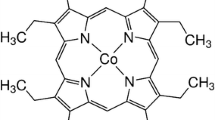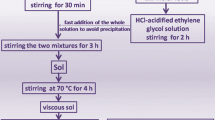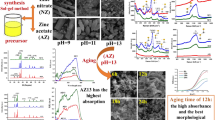Abstract
Hybrid materials based on zinc phthalocyanine (ZnPc) and modified silica glass matrix (Organically Modified Silicate; ORMOSIL) were synthesized by the sol–gel method using protic solvents (methanol, ethanol, isopropanol, butanol) and aprotic solvents (N,N-dimethylformamide; DMF, tetrahydrofuran, (THF); dichloromethane (DMC)) and non-polar 1,4-dioxane. The effect of sol–gel route with NaOH or NH4OH addition (a single stage process) and acid-alkaline environment based on HCl-NaOH (a two-stage process) was analyzed over time. ZnPc stability in the ORMOSIL sols was monitored by UV–Vis spectroscopy. The highest stability of zinc phthalocyanine in the glass was obtained for synthesis with isopropanol. The lowest stability of ZnPc is observed when the non-polar and DMF are used as a solvent for the synthesis. The thermal stability of the materials was studied by TG-DSC methods. Additional influence of organic base such as pyridine was analyzed. Dissolution of ZnPc in the pyridine causes cessation of degradation for two months. Thermoluminescence (TL) study showed significant impact of the solvent on intensity of the ZnPc signal in the UV range.








Similar content being viewed by others
References
Shirota Y, Kageyama H. Handbook of organic materials for optical devices. Amsterdam: Elsevier; 2013.
Kalyani NT, Swart H, Dhoble S. Principles and applications of organic light emitting diodes (OLEDs). Amsterdam: Elsevier; 2017.
Arslan S. Phthalocyanines: structure, synthesis, purification and applications. J Life Sci. 2016;6:188–97.
Trytek M, Makarska M, Polska K, et al. Porfiryny i ftalocyjaniny Cz. I. Właściwości i niektóre zastosowania. Biotechnologia. 2005;71:109–27.
Eastwood D, Edwards L, Gourterman M, et al. Spectra of porphyrins part VII.: vapor absorption and emission of phthalocyanines. J Mol Spectrosc. 1966;20:381–90.
Savolainen J, van der Linden D, Dijkhuizen N, Herek JL. Characterizing the functional dynamics of zinc phthalocyanine from femtoseconds to nanoseconds. J Photochem Photobiol A. 2008;196:99–105.
Guglielmi M, Brusatin G, Della GG. Hybrid glass-like films through sol–gel techniques. J Non Cryst Solids. 2007;353:1681–7.
Chu C-S. Optical fiber oxygen sensor based on Pd(II) complex embedded in sol–gel matrix. J Lumin. 2013;135:5–9.
Dash S, Mishra S, Patel S, Mishra BK. Organically modified silica: synthesis and applications due to its surface interaction with organic molecules. Adv Colloid Interface Sci. 2008;140:77–94.
Kamimura Y, Kurumada K. Evaluation of molecular volume of siloxane bonding and phenyl group in partially phenylated organic/inorganic hybrid glass. J Non Cryst Solids. 2008;354:3414–7.
Wu Z, You L, Xiang H, Jiang Y. Comparison of dye adsorption by mesoporous hybrid gels: understanding the interactions between dyes and gel surfaces. J Colloid Interface Sci. 2006;303:346–52.
Ulatowska A, Kudrawiec K, Podbielska H, Bryja L, Misiewicz J. Transmittance examination in sol-gel derived matrices for optoelectronic application. Opt Mater. 2001;17:247–50.
Nivens DA, Zhnag Y, Angel AM. A fiber-optic pH sensor prepared using a base-catalyzed organo-silica sol-gel. Anal Chim Acta. 1998;376:235–45.
Zayat M, Gracia-Parejo P, Levy D. Preventing UV-light damage of light sensitive materials using a highly protective UV-absorbing coating. Chem Soc Rev. 2007;36:1270–81.
Popanda B, Środa M, Cholewa-Kowalska K. Effect of solvent and catalyst types on stability and properties of zinc phthalocyanine in the organic-inorganic hybrid materials. Curr Comput-Aided Drug Des. 2021. https://doi.org/10.3390/cryst11060592.
Acebo C, Fernández-Francos X, Santos J-I, Messori M, Ramis X, Serra À. Hybrid epoxy networks from ethoxysilyl-modified hyperbranched poly(ethyleneimine) and inorganic reactive precursors. Eur Polym J. 2015;70:18–27.
Fortunati I, Signorini R, Bozio R, Brusatin G, Guglielmi M. Laser damage of glycidoxypropyltrimethoxysilane based hybrid materials. J Non Cryst Solids. 2008;354:3317–25.
Moriones P, Ríos X, Echeverría JC, Garrido JJ, Pires J, Pinto M. Hybrid organic–inorganic phenyl stationary phases for the gas separation of organic binary mixtures. Colloids Surf A Physicochem Eng Asp. 2011;389:69–75.
Kurumada K, Ashraf KM, Matsumoto S. Effects of heat treatment on various properties of organiceinorganic hybrid silica derived from phenyltriethoxysilane. Mater Chem Phys. 2014. https://doi.org/10.1016/j.matchemphys.2013.12.031.
Seoudi R, El-Bahy GS, El Sayed ZA. FTIR, TGA and DC electrical conductivity studies of phthalocyanine and its complexes. J Mol Struct. 2005;753:119–26.
Reddy R, Chaubal P, Pistorius PC, Pal U. Advances in molten slags, fluxes, and salts: proceedings of the 10th international conference on molten slags, fluxes and salts 2016. Cham: Springer; 2016.
Kuznetsova NA, Kaliya OL. Oxidative photobleaching of phthalocyanines in solution. J Porphyrins Phthalocyanines. 2012;301:705–12.
Gajda Ł, Kupka T, Broda MA. Solvent impact on the planarity and aromaticity of free and monohydrated zinc phthalocyanine: a theoretical study. Struct Chem. 2018;29:667–79.
Ciuffi KJ, Sacco HC, Valim JB, Manso CMCP, Serra OS, Nascimento OR, Vidoto EA, Iamamoto Y. Polymeric organic–inorganic hybrid material containing iron(III) porphyrin using sol–gel process. J Non Cryst Solids. 1999;247:146–52.
Iamamoto Y, Sacco HC, Biazzotto JC, Ciuffi KJ, Serra OS. Porphyrinosilica and metalloporphyrinosilica: hybrid organic-inorganic materials prepared by sol-gel processing. An Acad Bras Ci. 2000;72:59–66.
Uchida N, Ishiyama N, Kato Z, Uematsu K. Chemical effects of DCCA to the sol-gel reaction proces. J Mater Sci. 1994;29:5188–92.
Bangi UKH, Gafari RS, Pawar RC, Jung HNR, Park HH. Influence of glycerol additive on the chemical structure, hydrophobicity, morphology and optical properties of sol-gel based zirconia coatings. ES Mater Manuf. 2020;10:16–21.
Baldovi HG, Blas-Ferrando VM, Ortiz J, Garcia H, Fernández-Lázaro F, Sastre-Santos Á. Phthalocyanine-gold nanoparticle hybrids: modulating quenching with a silica matrix shell. Chem Phys Chem. 2016;17:1579–85.
Gerasymchuk YS, Chernii VY, Tomachynski LA, Legendziewicz L, Radzki S. Spectroscopic characterization of zirconium(IV) and hafniumf(IV) gallate phthalocyanines in monolithic silica gels obtained by sol–gel method. Opt Mater. 2005;27:1484–94.
Yong-Ho K, Byunghwan L, Kwang-Ho C, Sang-June C. Selective adsorption of bisphenol A by organic–inorganic hybrid mesoporous silicas. Microporous Mesoporous Mater. 2011;138:184–90.
Purcar V, Stamatin I, Cinteza O, Petcu C, Raditoiu V, Ghiurea M, Miclaus T, Andronie A. Fabrication of hydrophobic and antireflective coatings based on hybrid silica films by sol–gel proces. Surf Coat Technol. 2012;206:4449–54.
Hernández-Escolano M, Ramis X, Jiménez-Morales A, Juan-Díaz M, Suay J. Study of the thermal degradation of bioactive sol–gel coatings for the optimization of its curing process. J Therm Anal Calorim. 2012;107:499–508.
Al-Oweini R, El-Rassy H. Synthesis and characterization by FTIR spectroscopy of silica aerogels prepared using several Si(OR)4 and R”Si(OR)3 precursors. J Mol Struct. 2009;919:140–5.
Juan-Díaz MJ, Martínez-Ibáñez M, Lara-Sáez I, da Silva S, Izquierdo R, Gurruchaga M, Goñi I, Suay J. Development of hybrid sol–gel coatings for the improvement of metallic biomaterials performance. Prog Org Coat. 2016;96:42–51.
Ying-Sing L, Yu W, Sorrie C. Vibrational spectra of phenyltriethoxysilane, phenyltrimethoxysilane and their sol–gels. Spectrochim Acta A Mol Biomol Spectrosc. 2009;71:1819–24.
Acknowledgements
The authors would like to thank Dr Jarosław Grolik (Jagiellonian University), Prof. Katarzyna Cholewa-Kowalska (AGH University of Science and Technology) for advice on the preparation of experiments and Prof. Magdalena Szumera (AGH University of Science and Technology) for thermal analysis measurements. This work was supported from the subsidy of the Ministry of Education and Science for the AGH University of Science and Technology in Kraków (Project No 16.16.160.557).
Author information
Authors and Affiliations
Contributions
Conceptualization: Barbara Popanda; Methodology: Barbara Popanda, Marcin Środa, Wojciech Gieszczyk; Validation: Barbara Popanda, Wojciech Gieszczyk; Formal analysis: Barbara Popanda; Investigation: Barbara Popanda, Marcin Środa, Wojciech Gieszczyk; Resources: Barbara Popanda, Wojciech Gieszczyk; Data Curation: Barbara Popanda, Wojciech Gieszczyk; Writing – Barbara Popanda, Marcin Środa; Writing - Review & Editing: Barbara Popanda, Marcin Środa; Visualization: Barbara Popanda, Marcin Środa; Supervision: Barbara Popanda, Marcin Środa; Project administration: Barbara Popanda; Funding acquisition: Marcin Środa
Corresponding author
Ethics declarations
Conflict of interest
Authors declared no conflict of interest.
Additional information
Publisher's Note
Springer Nature remains neutral with regard to jurisdictional claims in published maps and institutional affiliations.
Supplementary Information
Below is the link to the electronic supplementary material.
Rights and permissions
About this article
Cite this article
Popanda, B., Środa, M. & Gieszczyk, W. Effect of solvents, catalysts and drying agent addition on the thermal stability of zinc phthalocyanine in the hybrid sol–gel matrix. J Therm Anal Calorim 147, 9987–9997 (2022). https://doi.org/10.1007/s10973-022-11373-w
Received:
Accepted:
Published:
Issue Date:
DOI: https://doi.org/10.1007/s10973-022-11373-w




